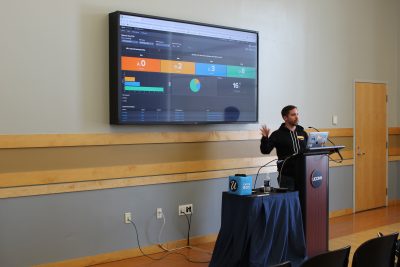 On Friday, March 8th, OPIM Innovate hosted Splunk Day in collaboration with Splunk, Inc., the industry leader in operations analytics software. Held in the Student Union, the six-hour event introduced students and faculty to the Splunk software, Splunk’s organizational culture, and ways to get involved with the company and their various applications. The event was kicked-off by Ryan O’Connor, Senior Advisory Engineer at Splunk and adjunct professor of the Operations and Information Management Department at the UConn School of Business. To give attendees an understanding of what Splunk can do, O’Connor introduced the software and its capabilities as both a data-visualization tool and a data-monitoring platform.
On Friday, March 8th, OPIM Innovate hosted Splunk Day in collaboration with Splunk, Inc., the industry leader in operations analytics software. Held in the Student Union, the six-hour event introduced students and faculty to the Splunk software, Splunk’s organizational culture, and ways to get involved with the company and their various applications. The event was kicked-off by Ryan O’Connor, Senior Advisory Engineer at Splunk and adjunct professor of the Operations and Information Management Department at the UConn School of Business. To give attendees an understanding of what Splunk can do, O’Connor introduced the software and its capabilities as both a data-visualization tool and a data-monitoring platform.
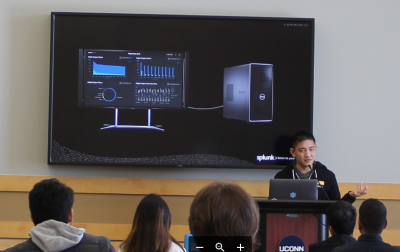 After O’Connor’s brief introduction of Splunk, Glen Wong, Senior Engineering Manager at Splunk, took to the podium to give attendees an inside look at the endeavors of the Splunk Mobile Team. The Mobile Team’s mission is to make Splunk accessible, not just on laptops and desktops, but also on phones, tablets, televisions, smart watches, and so on. With applications like Splunk Mobile, Splunk users can pull up useful dashboards and receive notifications and alerts when pertinent changes are made to their unique Splunk environment. Splunk TV, another application developed by the Mobile Team for Apple TV, specifically, allows users to pull up multiple saved dashboards and search through data using voice recognition.
After O’Connor’s brief introduction of Splunk, Glen Wong, Senior Engineering Manager at Splunk, took to the podium to give attendees an inside look at the endeavors of the Splunk Mobile Team. The Mobile Team’s mission is to make Splunk accessible, not just on laptops and desktops, but also on phones, tablets, televisions, smart watches, and so on. With applications like Splunk Mobile, Splunk users can pull up useful dashboards and receive notifications and alerts when pertinent changes are made to their unique Splunk environment. Splunk TV, another application developed by the Mobile Team for Apple TV, specifically, allows users to pull up multiple saved dashboards and search through data using voice recognition.
 During the Splunk Mobile presentation, Devin Bhushan, Senior iOS Engineer for augmented reality (AR), showed audience members a live Splunk AR demo. Augmented reality is an emerging technology that superimposes digital modules, animations, images, and videos onto the real world through a mobile device. For Splunk AR, various augmented reality modules can be placed onto the physical environment through the use of a near field communication (NFC) tag. The NFC tag holds the information of a specific Splunk dashboard, and gives Splunk AR users the ability to see how that data is changing in real time. For example, if Splunk is capturing how hot a certain device is, Splunk AR can place a digital temperature gauge on that device. This versatile technology can also be used in manufacturing to track the movement of inventory.
During the Splunk Mobile presentation, Devin Bhushan, Senior iOS Engineer for augmented reality (AR), showed audience members a live Splunk AR demo. Augmented reality is an emerging technology that superimposes digital modules, animations, images, and videos onto the real world through a mobile device. For Splunk AR, various augmented reality modules can be placed onto the physical environment through the use of a near field communication (NFC) tag. The NFC tag holds the information of a specific Splunk dashboard, and gives Splunk AR users the ability to see how that data is changing in real time. For example, if Splunk is capturing how hot a certain device is, Splunk AR can place a digital temperature gauge on that device. This versatile technology can also be used in manufacturing to track the movement of inventory.
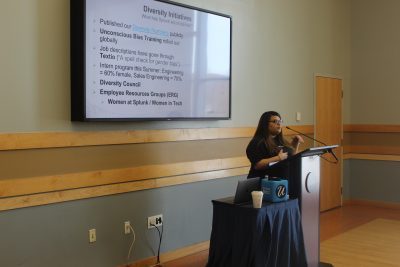 On the topic of Splunk’s organizational culture, the next presentation centered around Women in Technology. Khadija Yamin, a Splunk Sales Engineer, started this part of the event with a few important statistics. For one, there are currently only about 26% of women in technology-related fields, with female minorities being even less represented. In addition, 56% of women in technical fields leave their jobs at the mid-level, which is a very costly point in time for an organization to lose an employee. What Splunk does to avoid this is to promote an inclusive culture, which is encouraged by mandatory unconscious bias training. They also regularly utilize textio, described by Yamin as “a spell check for gender bias,” for written communication. Though, to Yamin, inclusivity has to be present in the lives of women and other minorities pursuing roles in the technological field even before they reach Splunk to be the most effective. When I asked Yamin what both men and women can do at the college level to support women who want to pursue technological roles, she stated: “Stay involved with your female colleagues and classmates, don’t make derogatory jokes, and be respectful of the pursuits of both sexes. You can’t look at a person and expect them to not understand something because they are female or male. You have to look beyond that–we are equally capable human beings.”
On the topic of Splunk’s organizational culture, the next presentation centered around Women in Technology. Khadija Yamin, a Splunk Sales Engineer, started this part of the event with a few important statistics. For one, there are currently only about 26% of women in technology-related fields, with female minorities being even less represented. In addition, 56% of women in technical fields leave their jobs at the mid-level, which is a very costly point in time for an organization to lose an employee. What Splunk does to avoid this is to promote an inclusive culture, which is encouraged by mandatory unconscious bias training. They also regularly utilize textio, described by Yamin as “a spell check for gender bias,” for written communication. Though, to Yamin, inclusivity has to be present in the lives of women and other minorities pursuing roles in the technological field even before they reach Splunk to be the most effective. When I asked Yamin what both men and women can do at the college level to support women who want to pursue technological roles, she stated: “Stay involved with your female colleagues and classmates, don’t make derogatory jokes, and be respectful of the pursuits of both sexes. You can’t look at a person and expect them to not understand something because they are female or male. You have to look beyond that–we are equally capable human beings.”
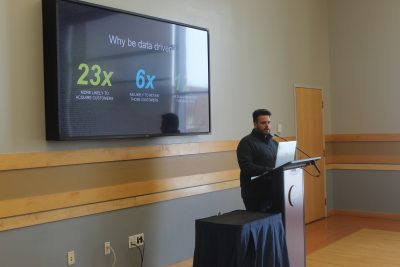 For Brian Gilmore, Splunk’s Chief Technology Advocate and speaker for the Industrial Internet of Things (IoT) portion of Splunk Day, a pattern he consistently faced in his early professional career was that useful data was not being explored by systems specialists. During his time at the Georgia Aquarium as an aquarist and life support manager, for example, he found that the automation control systems that kept “the animals healthy and the water clear” were not being utilized for business insight. As a result, he built connectivity to those systems, which controlled all tank valves, filters, sensors, and activators, by creating a way to feed that data into Excel. When he began to work with Splunk, he sought to use the Splunk platform as a more efficient medium between the machine and the man, which is basically what Internet of Things is all about.
For Brian Gilmore, Splunk’s Chief Technology Advocate and speaker for the Industrial Internet of Things (IoT) portion of Splunk Day, a pattern he consistently faced in his early professional career was that useful data was not being explored by systems specialists. During his time at the Georgia Aquarium as an aquarist and life support manager, for example, he found that the automation control systems that kept “the animals healthy and the water clear” were not being utilized for business insight. As a result, he built connectivity to those systems, which controlled all tank valves, filters, sensors, and activators, by creating a way to feed that data into Excel. When he began to work with Splunk, he sought to use the Splunk platform as a more efficient medium between the machine and the man, which is basically what Internet of Things is all about.
Internet of Things, in an industrial context, is connecting any data-generating device to the internet for efficiency and insight. Splunk assists many companies in this area of emerging technology by giving them the data necessary to optimize their business models, minimize costs and generate optimal revenues. For example, Dubai Airlines partnered with Splunk to optimize their customer service model and keep track of utility usage. Due to this implementation and the data collected from customer checkpoints, Dubai Airlines can now get a customer from the front door to their gate in five minutes. They can also restock toiletries, such as hand soap, paper towels, and toilet paper, in a timely manner due to IoT sensors on toilets and sinks.
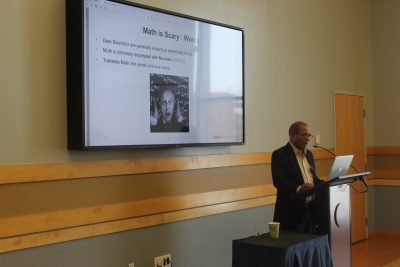
According to Rao Durvasula, Senior Instructor at Splunk and the presenter of the Machine Learning portion of Splunk Day, “You’re not a data scientist if you can’t articulate the problem in English.” So, when it comes to Splunk Analytics and its Machine Learning Toolkit, exploration is the best method for implementation. The moment you install Splunk, you can utilize the Machine Learning Toolkit as a free add-on to explore predictive analytics such as linear regression and logistic regression. These algorithms help you create future insights from present and past data and can assist you in making business decisions. In addition, the Toolkit gives you an opportunity to start understanding predictive models and machine learning for future communication.
As we have seen, Splunk can be used in a variety of ways, from gathering IoT information to making machine learning predictions. However, its capabilities do not stop there–it can also be used as a security client. During the Security portion of Splunk Day, Khadija Yamin returned to explain Splunk Enterprise Security, which helps organizations identify security concerns. For users who have the regular version of Splunk, Splunk Enterprise, they can install Splunk Security Essentials, a free add-on that helps detect security anomalies. As it takes, on average, 146 days for organizations to find out if they were hacked, having a security client is very necessary. And, Splunk Enterprise Security has been the top in Security Information and Event Management for 6 years, meaning that they are the optimal choice.
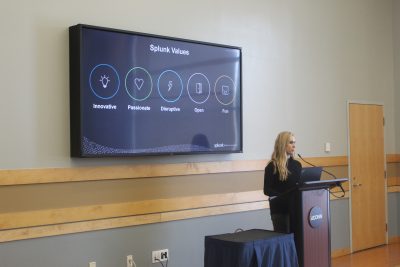 At the end of the informative portion of Splunk Day, the final presenter, University Recruiting Manager Katia Ratkovitch, described the “Perfect Splunker.” They are a person who is a team player, who enjoys building (or innovating), who is inclusive, who values personal growth, and who takes action when other people don’t. The Splunk environment thrives off of these individuals, and thus holds the values of being innovative, passionate, disruptive (ahead of the competition), open, and fun. If you are interested in this type of environment, consider Splunk’s 10-12 week internship program! Every intern has a mentor, works on a real-world project with a real-world team, and participates in fun events like a one-week hackathon. While most internship positions have been filled for the summer of 2019, please feel free to browse their internships and full-time positions for future opportunities.
At the end of the informative portion of Splunk Day, the final presenter, University Recruiting Manager Katia Ratkovitch, described the “Perfect Splunker.” They are a person who is a team player, who enjoys building (or innovating), who is inclusive, who values personal growth, and who takes action when other people don’t. The Splunk environment thrives off of these individuals, and thus holds the values of being innovative, passionate, disruptive (ahead of the competition), open, and fun. If you are interested in this type of environment, consider Splunk’s 10-12 week internship program! Every intern has a mentor, works on a real-world project with a real-world team, and participates in fun events like a one-week hackathon. While most internship positions have been filled for the summer of 2019, please feel free to browse their internships and full-time positions for future opportunities.
Following of Splunk Day, students began to network with the various Splunk employees that presented during the event. One of these students was Joanne Cheong (MIS ’19), a Lab Specialist at OPIM Innovate who enthusiastically agreed to tell me about her experience. “Splunk day provided me with great insight on what the company does. I already knew about Splunk from the tech kits I write for the Innovate Lab, but I learned a lot more about how Splunk can be used in areas like operational intelligence and cybersecurity. And, given that I’m a [Management Information Systems] major, it’s great to have a platform where you can experiment with data for different purposes.”
Splunk, as an organization, tries its best to promote social change and stimulate personal growth. It is no wonder their motto for employees is, “If you’re not growing, you’re dying”–growth is something they strive for, not just for themselves but for the communities around them. Through Splunk4Good, Splunk sponsors various educational institutions, including UConn, to give students the ability to build valuable skillsets while learning to use the Splunk Analytics platform. That way, they can use Splunk, and their understanding of data analytics, to positively influence the progress and growth of various organizations striving to make an impact.
If you would like to learn more about Splunk, I encourage you to take Splunk Fundamentals I and II. They are free Splunk courses for UConn students, and give you a first step towards an amazing skillset.

 On Thursday, November 21st, OPIM Innovate hosted a rotational virtual reality (VR) and augmented reality (AR) workshop for UConn’s Management and Engineering for Manufacturing program (MEM). Here, students from Professor Mousumi Roy’s MEM3221 class were tasked with brainstorming ways in which either VR or AR can be integrated into the manufacturing process.
On Thursday, November 21st, OPIM Innovate hosted a rotational virtual reality (VR) and augmented reality (AR) workshop for UConn’s Management and Engineering for Manufacturing program (MEM). Here, students from Professor Mousumi Roy’s MEM3221 class were tasked with brainstorming ways in which either VR or AR can be integrated into the manufacturing process. 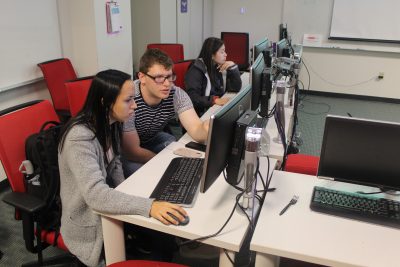 On Friday, April 26th, OPIM Innovate hosted its 3D Printing Workshop. There, lab specialist
On Friday, April 26th, OPIM Innovate hosted its 3D Printing Workshop. There, lab specialist 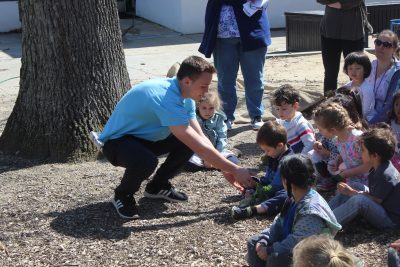 On Wednesday, April 28th, Levo International, in collaboration with OPIM Innovate, showcased one of its many hydroponic installations to preschoolers at the
On Wednesday, April 28th, Levo International, in collaboration with OPIM Innovate, showcased one of its many hydroponic installations to preschoolers at the  So, how does it work? Well, the hydroponic greenhouse is fueled by a nutrient reservoir filled mostly with nitrogen, potassium, and phosphorus. From there, the water is pumped up to the top of the greenhouse, where it then flows through all the pipes to the seated plants. After the water reaches each plant, it returns to the reservoir and is recycled on a solar-powered timer. All a user has to do is check the roots of the plants to prevent the system from clogging and replace the fertilizer every two-to-three weeks. “That was our goal: eliminate most of the hassle,” said Heiden in his explanation of the system. “Especially in the United States, people are always on a time crunch.”
So, how does it work? Well, the hydroponic greenhouse is fueled by a nutrient reservoir filled mostly with nitrogen, potassium, and phosphorus. From there, the water is pumped up to the top of the greenhouse, where it then flows through all the pipes to the seated plants. After the water reaches each plant, it returns to the reservoir and is recycled on a solar-powered timer. All a user has to do is check the roots of the plants to prevent the system from clogging and replace the fertilizer every two-to-three weeks. “That was our goal: eliminate most of the hassle,” said Heiden in his explanation of the system. “Especially in the United States, people are always on a time crunch.”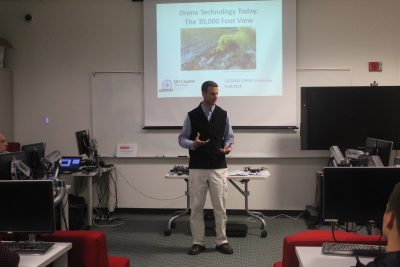 On Friday, April 19th, OPIM Innovate invited
On Friday, April 19th, OPIM Innovate invited 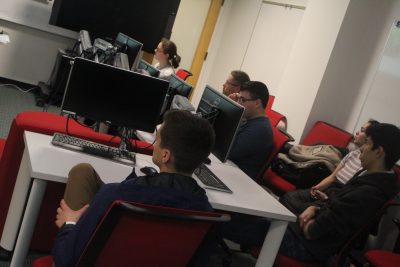 “My intention was to start an IT training company,” said Otrin while reminiscing about his business prototyping days. “But, deep down, it wasn’t really what I wanted. One of my mentors helped me realize that. After working on a 45-page business plan for 4 months, she said to me, ‘You know what, I can tell that this isn’t what lights you up.'” She asked Otrin to think about his childhood interests, his hobbies, what he reads, and his pastimes to steer him in the right direction in terms of creating a business he would enjoy running. It didn’t take long for him to pinpoint that he wanted to do something with aviation. “I went to airshows, read aviation magazines, was obsessed with flying–so I came back a week later and told her that I needed to do something aviation related.” Based on how quickly he wrote his second business plan, he realized that following his passions would lead to his success.
“My intention was to start an IT training company,” said Otrin while reminiscing about his business prototyping days. “But, deep down, it wasn’t really what I wanted. One of my mentors helped me realize that. After working on a 45-page business plan for 4 months, she said to me, ‘You know what, I can tell that this isn’t what lights you up.'” She asked Otrin to think about his childhood interests, his hobbies, what he reads, and his pastimes to steer him in the right direction in terms of creating a business he would enjoy running. It didn’t take long for him to pinpoint that he wanted to do something with aviation. “I went to airshows, read aviation magazines, was obsessed with flying–so I came back a week later and told her that I needed to do something aviation related.” Based on how quickly he wrote his second business plan, he realized that following his passions would lead to his success.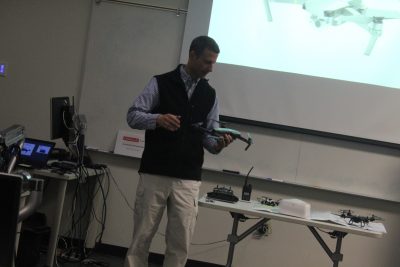 Outside of recreational use, drones have many practical applications that can be beneficial to various industries. They allow human beings to get to places they may not otherwise be able to go, see things from an overhead perspective, and make informed decisions. For instance:
Outside of recreational use, drones have many practical applications that can be beneficial to various industries. They allow human beings to get to places they may not otherwise be able to go, see things from an overhead perspective, and make informed decisions. For instance: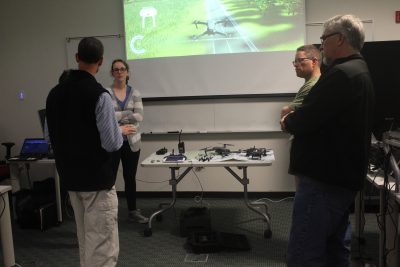 After the workshop, students left with a better understanding of drones and how they can utilize drone technology in their own pursuits. “I’ve had this idea for a while now to use drones as a way to help commuters find available parking spaces,” said computer science major
After the workshop, students left with a better understanding of drones and how they can utilize drone technology in their own pursuits. “I’ve had this idea for a while now to use drones as a way to help commuters find available parking spaces,” said computer science major 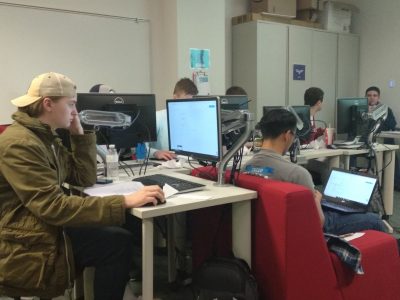 On Friday, March 29th, OPIM Innovate hosted its Alexa Skill-Building Workshop from 1:00 PM to 3:00 PM in the Gladstein Lab, BUSN 309. Led by
On Friday, March 29th, OPIM Innovate hosted its Alexa Skill-Building Workshop from 1:00 PM to 3:00 PM in the Gladstein Lab, BUSN 309. Led by 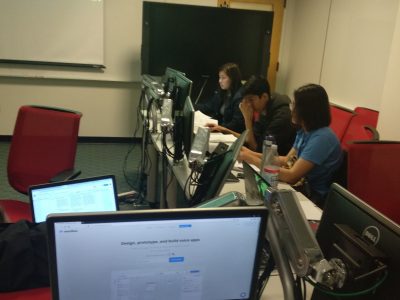 In addition to the A.I. exposition of the workshop, Lauretti also clarified a few common, yet incorrect assumptions about the Amazon Alexa. For one, the Alexa cannot be purchased from Amazon, unlike their Echo and Dot smart speakers. Why? Unlike Amazon’s physical hardware, the Alexa is a cloud-based voice service that connects to all Amazon smart devices and some third-party devices. As such, while Alexa is a complement to Amazon’s smart speakers, she is also the overarching artificial intelligence framework that keeps every device responsive. When Alexa is asked something through a smart speaker, for example, a recording of the request is sent to the Amazon cloud for processing and analysis. Then, once the meaning of the message is predicted, Alexa gives you her best response.
In addition to the A.I. exposition of the workshop, Lauretti also clarified a few common, yet incorrect assumptions about the Amazon Alexa. For one, the Alexa cannot be purchased from Amazon, unlike their Echo and Dot smart speakers. Why? Unlike Amazon’s physical hardware, the Alexa is a cloud-based voice service that connects to all Amazon smart devices and some third-party devices. As such, while Alexa is a complement to Amazon’s smart speakers, she is also the overarching artificial intelligence framework that keeps every device responsive. When Alexa is asked something through a smart speaker, for example, a recording of the request is sent to the Amazon cloud for processing and analysis. Then, once the meaning of the message is predicted, Alexa gives you her best response.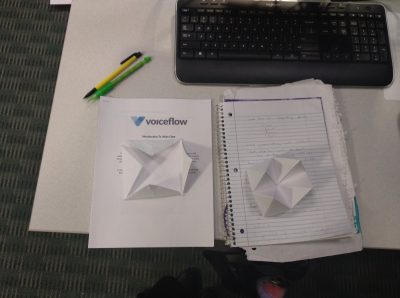 Before utilizing Voiceflow, Lauretti had attendees create paper fortune tellers (shown to the right). The point of the exercise was to show how Alexa can only process voice information, and cannot utilize any other “senses” in order to make a decision. As such, while paper fortune tellers require you to pull, fold, unfold, and process visual information, Alexa cannot do that with her limitations; she can only be programmed to listen and respond. Thus, when attendees began to use Voiceflow, which allows you to chain commands and responses together in a circular decision-tree-like diagram, all of the different blocks available for use on the graphical interface involved either speaking or listening for information. For example, in emulating a paper fortune teller game, a “Speak” block can be created with directions on which color to pick so Alexa can voice them to the user. Then, that “Speak” block can be chained to a “Choice” block outlining all of the different choices to search for in the voice input (blue, red, yellow, or green, for example). If the user does not pick a color on that list, the “Choice” block can be linked back to the “Speak” block through an “else” option so Alexa can clarify the different color choices, again. As can be inferred, an Alexa skill diagram utilizing Voiceflow can become very involved very quickly. However, even if the visual model can become fairly complex, it is very simple to build.
Before utilizing Voiceflow, Lauretti had attendees create paper fortune tellers (shown to the right). The point of the exercise was to show how Alexa can only process voice information, and cannot utilize any other “senses” in order to make a decision. As such, while paper fortune tellers require you to pull, fold, unfold, and process visual information, Alexa cannot do that with her limitations; she can only be programmed to listen and respond. Thus, when attendees began to use Voiceflow, which allows you to chain commands and responses together in a circular decision-tree-like diagram, all of the different blocks available for use on the graphical interface involved either speaking or listening for information. For example, in emulating a paper fortune teller game, a “Speak” block can be created with directions on which color to pick so Alexa can voice them to the user. Then, that “Speak” block can be chained to a “Choice” block outlining all of the different choices to search for in the voice input (blue, red, yellow, or green, for example). If the user does not pick a color on that list, the “Choice” block can be linked back to the “Speak” block through an “else” option so Alexa can clarify the different color choices, again. As can be inferred, an Alexa skill diagram utilizing Voiceflow can become very involved very quickly. However, even if the visual model can become fairly complex, it is very simple to build.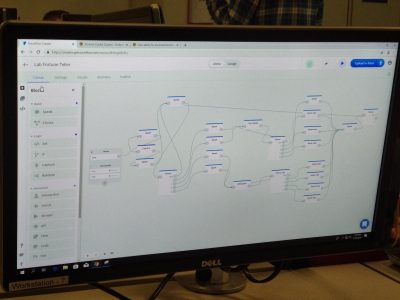 After the Alexa Skill-Building Workshop, many students left with a greater understanding of the Alexa service and Alexa skills. “I didn’t realize how simple it was to make skills for your Alexa,” said
After the Alexa Skill-Building Workshop, many students left with a greater understanding of the Alexa service and Alexa skills. “I didn’t realize how simple it was to make skills for your Alexa,” said  On Friday, March 8th, OPIM Innovate hosted Splunk Day in collaboration with Splunk, Inc., the industry leader in operations analytics software. Held in the Student Union, the six-hour event introduced students and faculty to the Splunk software, Splunk’s organizational culture, and ways to get involved with the company and their various applications. The event was kicked-off by
On Friday, March 8th, OPIM Innovate hosted Splunk Day in collaboration with Splunk, Inc., the industry leader in operations analytics software. Held in the Student Union, the six-hour event introduced students and faculty to the Splunk software, Splunk’s organizational culture, and ways to get involved with the company and their various applications. The event was kicked-off by  After O’Connor’s brief introduction of Splunk,
After O’Connor’s brief introduction of Splunk,  During the Splunk Mobile presentation,
During the Splunk Mobile presentation,  On the topic of Splunk’s organizational culture, the next presentation centered around Women in Technology.
On the topic of Splunk’s organizational culture, the next presentation centered around Women in Technology.  For
For 
 At the end of the informative portion of Splunk Day, the final presenter, University Recruiting Manager
At the end of the informative portion of Splunk Day, the final presenter, University Recruiting Manager 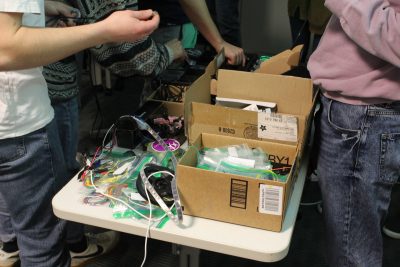 On Friday, March 1st, OPIM Innovate hosted its Wearable Tech in Action workshop from 1:00 PM to 3:00 PM in the Gladstein Lab. There, students were able to use hardware such as FLORA microcontrollers, UV light sensors, and force sensors to design their own wearable technologies with pre-coded software templates created using Arduino, an open-source electronic prototyping software. There were multiple projects students could choose from based on the parts they selected from the toolkit supplied by the event instructor. Encouraged to work on their own, students downloaded the Arduino software, began building their wearable technologies, and experimented with changing light colors and cycle times by altering the code provided to them on the workshop’s
On Friday, March 1st, OPIM Innovate hosted its Wearable Tech in Action workshop from 1:00 PM to 3:00 PM in the Gladstein Lab. There, students were able to use hardware such as FLORA microcontrollers, UV light sensors, and force sensors to design their own wearable technologies with pre-coded software templates created using Arduino, an open-source electronic prototyping software. There were multiple projects students could choose from based on the parts they selected from the toolkit supplied by the event instructor. Encouraged to work on their own, students downloaded the Arduino software, began building their wearable technologies, and experimented with changing light colors and cycle times by altering the code provided to them on the workshop’s 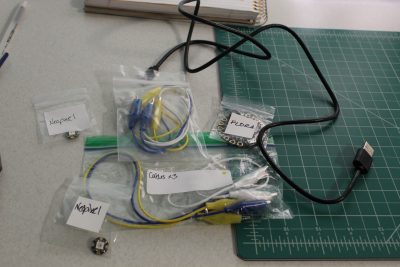 Since this was the first time I had ever created a wearable piece of technology, I decided to build an accessory that utilized a FLORA microcontroller and a neopixel light. Thanks to the diagrams available to us when using the GitHub tutorials, it was not that difficult to put together. In all, it took one micro USB cord connected to my laptop to power the FLORA microcontroller and upload the Arduino code. From there, I had to use three alligator clips and three on-board pads, or points of contact between devices, on both the FLORA microcontroller and the neopixel light to individuate the electric pulses that would make the device work properly given the current code. Once everything was connected, the neopixel light began to cycle through different colors. At first, the device ran on a red, green, and blue cycle. Then I changed the colors to aqua blue, purple, and pastel pink.
Since this was the first time I had ever created a wearable piece of technology, I decided to build an accessory that utilized a FLORA microcontroller and a neopixel light. Thanks to the diagrams available to us when using the GitHub tutorials, it was not that difficult to put together. In all, it took one micro USB cord connected to my laptop to power the FLORA microcontroller and upload the Arduino code. From there, I had to use three alligator clips and three on-board pads, or points of contact between devices, on both the FLORA microcontroller and the neopixel light to individuate the electric pulses that would make the device work properly given the current code. Once everything was connected, the neopixel light began to cycle through different colors. At first, the device ran on a red, green, and blue cycle. Then I changed the colors to aqua blue, purple, and pastel pink.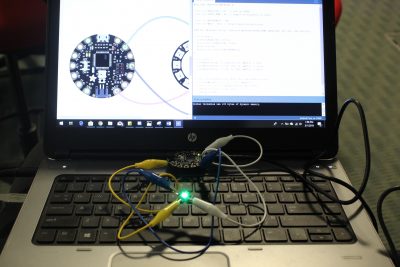 As I continued to experiment with my wearable accessory, I found that you could do various things with the code. For one, you could decrease the brightness of the lights, or even add an extra color to the current hue loop. Looking around me, I also saw my peers use Arduino to create color waves utilizing the neopixel strip, which carries 60 individual neopixels inside of it. Light traveled up and down the strip in a single color, something that could have become a rainbow arrangement with a little extra time.
As I continued to experiment with my wearable accessory, I found that you could do various things with the code. For one, you could decrease the brightness of the lights, or even add an extra color to the current hue loop. Looking around me, I also saw my peers use Arduino to create color waves utilizing the neopixel strip, which carries 60 individual neopixels inside of it. Light traveled up and down the strip in a single color, something that could have become a rainbow arrangement with a little extra time.